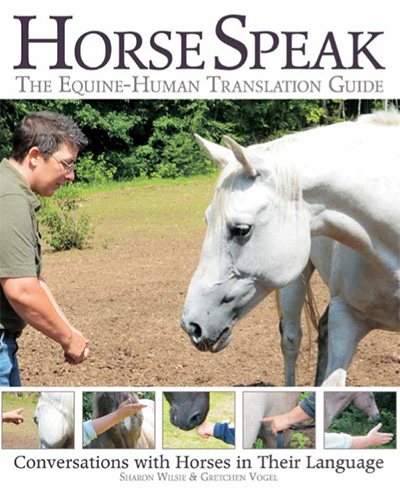
by Sharon Wilsie and Gretchen Vogel
This excerpt is reprinted with permission from Trafalgar Square Books.
Humans greet each other with a formal handshake the first time they meet, and horses have a similar system. The Greeting Ritual is the basic platform I have created to teach humans how Conversations with horses can exist.
The Greeting Ritual consists of three separate moments in which horses that are meeting touch noses on the Greeting Button. The speed at which they may perform these three touches varies from lightning-fast to very slow.
The reason for three official touches is simple: there is much to say in a first, formal greeting, and it takes two subsequent touches to sort it all out. Plus, I find that horses learn about the world around them in processes of three or more.
First Touch: Formal Greeting, “Hello,” and Copycat
A horse’s pecking order is different from a dog’s, for example, because horses are concerned with how to run and move together in case of emergency. In a horse’s world, any moment could bring danger, and the more alpha a horse is in pecking order, the more responsible that horse is for fending off attackers.
In dog psychology, the alpha dog calls the shots, but in horse psychology, to lead is to be responsible for the welfare of those that are weaker. The only difference in horse social order occurs between stallions. A herd is typically made up of grandmothers, aunts, mothers, and daughters.
There is one dominant stallion, and he not only guards his ladies from other rogue stallions, but from mountain lions, wolves, and bears. Stallions that have no mares band together in bachelor herds, and although they can enjoy some rowdy play, they tend to develop strong emotional bonds with each other and follow the same herd dynamics as any other herd.
Domestic horses are bought and sold and moved from barn to barn, and have to deal with new herd members often. Sometimes they are not turned out directly with other horses and can only socialize over a fence, if at all. But the formal Greeting Ritual remains essential for horses who are just meeting each other to be able to sort out who will tell who what to do.
The First Touch is much like a formal human handshake. It is the “Hello” followed by an immediate question: “Where are you in the pecking order?” Horses size each other up and assess very quickly as much as they can about each other’s herd status.
There is much more to it than just calling one “Alpha,” because a healthy herd has many diverse roles that get played out: the “Peacemaker,” the “Bully,” the “Sentry,” and the “Joker,” to name a few.
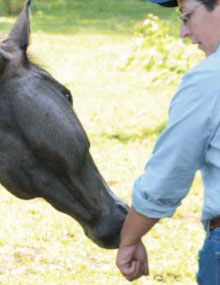
Immediately after the first nose touch, one horse will make a move in one direction or the other, which can be as subtle as a shift of the head position. The question is: “If I want to go that way, will you follow?” I call this Copycat, because in a friendly exchange, one horse will Copycat the other’s movement to indicate, “Yes, I will follow you.”
Second Touch: Getting to Know You and Copycat
After the delicate first encounter, there will be a second nose touch, usually with a deep inhale. This touch is a getting-to-know-you breath and will usually be accompanied by another Copycat gesture to confirm the leader/follower roles.
This step can be performed slowly or very quickly depending on the personalities of the horses.
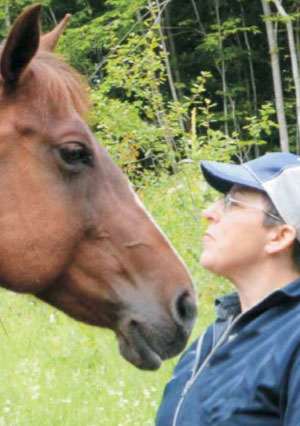
Third Touch: What’s Next?
Now the third and final nose touch can occur. This touch is the lead to other avenues of contact or the opportunity for the horses to break contact and go their separate ways. The Third Touch is important and in a superfast greeting ritual—such as may be likely to occur between two highly charged horses—this final straw can erupt into squealing, striking, or other displays of contest or play.
However, in relaxed horses this touch leads to the other Gs: Going Somewhere, Grooming, or even Gone. This is when the peaceful herd dynamic that horses desire most starts to emerge.
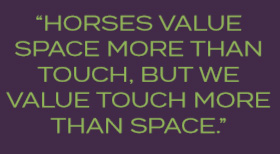
Luckily for us, horses seem to be impressed when humans figure out to extend their knuckles in one “Hello” touch, and they are happy to welcome us into their world even without the entire formal Greeting Ritual.
However, when a person can perform the whole Greeting Ritual, there is so much information exchanged that both parties will feel a much more intimate and intense understanding of each other.
Conversation: Greeting Ritual 1
1 Knuckle Touch to the horse’s Greeting Button to say, “Hello,” followed by an obvious turn to the side to see if the horse will Copycat your movement and offer to be your follower. The Knuckle Touch should be made with your hand in a soft fist, knuckles up.
2 A second Knuckle Touch to say, “Getting to know you!” followed by one more turn to the side to confirm the horse will offer to follow you.
3 A third Knuckle Touch to say, “What’s next?” with soft breathing. This could lead to you going somewhere together, grooming, or separating peacefully. The third touch is where the next level of Conversation begins. This is also where some inherent differences in what humans and horses value can lead to misinterpretations of actions.
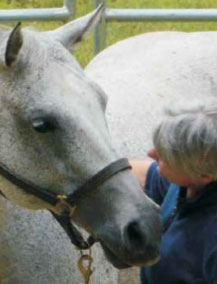
Excerpt from Horse Speak: The Equine-Human Translation Guide by Sharon Wilsie and Gretchen Vogel reprinted with permission from Trafalgar Square Books at www.horseandriderbooks.com, a small company based on a farm in rural Vermont. For more information about Horse Speak or authors Sharon Wilsie and Gretchen Vogel, contact: Rebecca Didier | Trafalgar Square Books Email: rdidier@trafalgarbooks.com Phone: 800.423.4525

































